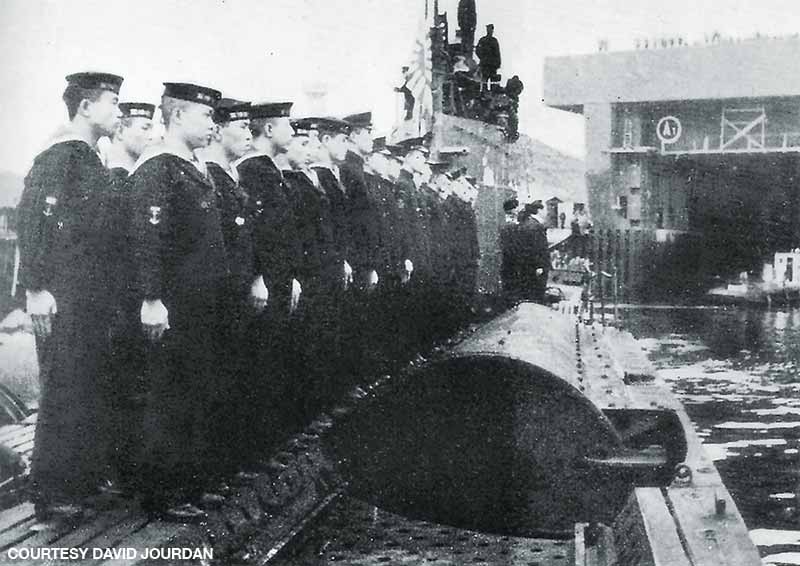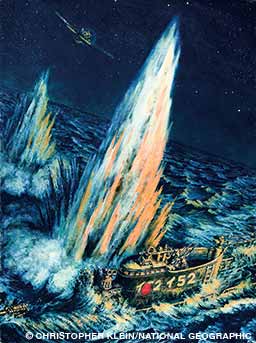A project of extremes
The story of the search for the Japanese submarine I-52 is one of two discoveries separated by time and purpose. In the dark of night on the open Atlantic Ocean in 1944, a group of U.S. Navy anti-submarine ships searched for a clandestine meeting between German and Japanese naval crews. Operating on captured intelligence, they sought to surprise and sink the two submarines that were supposed to exchange military information. Half a century later, the I-52 still rested undiscovered on the seafloor, but this time the search was in the dark of the deep ocean in pursuit of possibility, not destruction.
In the course of World War II, the Axis powers agreed to transfer resources between their countries using submarines, which were harder to locate and sink than surface ships. The secret exchanges between Germany and Japan, which the Japanese called Yanagimissions, relied on round-trip voyages from Japan to German-occupied France and back. Of the first few submarines that attempted the long route around South Africa’s Cape of Good Hope, only the I-8 completed the entire round trip.

The fifth Japanese submarine to attempt a Yanagimission, the I-52, was a massive vessel at 356 feet long with a 31-foot beam. The ship departed Kure, Japan, on March 10, 1944, with a crew of 95 officers and enlisted submariners as well as 14 civilian engineers and technicians, who were poised to bring back military information to Japan. The sub also carried a cargo of raw materials to help supply the German war effort. While en route to Lorient, France, the I-52 received a message on June 6, 1944, that the Allies had landed in Normandy and might control the French port before the submarine would arrive. For now, the sub had orders to rendezvous with the German submarine U-530 west of the Cape Verde Islands in the middle of the Atlantic Ocean.
The two ships met and transferred three crew members and a radar detector from the U-530 to the I-52. Unknown to Japan or Germany, the U.S. Navy had been intercepting communications from the I-52 since its first transmission and had sent the USS Bogueescort aircraft carrier group to destroy both ships at the rendezvous. Avenger torpedo bombers that launched from the Boguesank the submerging I-52 with no survivors.

Author and former Navy submarine officer David W. Jourdan chronicles the sinking and discovery of the I-52, thelast Japanese submarine bound on a Yanagi mission for Europe. Building on his previous series of books covering similar topics, Jourdan recounts in Operation Rising Sun: The Sinking of Japan’s Secret Submarine I-52the Navy’s initial search for the submarine during the war alongside the search for its remains 50 years later.
After graduating from the U.S. Naval Academy and serving as a commissioned officer on a nuclear submarine during the Cold War, Jourdan began his career as a physicist at the Applied Physics Laboratory of Johns Hopkins University. He honed his expertise in naval oceanographic database systems and developed software and algorithms to analyze submarine and autonomous underwater vehicle navigation.

The Navy utilized Jourdan’s work to enhance its ability to track nuclear submarines. He founded a company, Meridian Sciences (now Nauticos), to support and perform ocean expeditions using his RENAV (renavigation) system — a reverse-engineering algorithm that helps project possible destinations from incomplete positional data. In 1995 the enigmatic maritime researcher Paul Tidwell sought their help to find the I-52.
Tidwell had discovered a Japanese manifest stating that 146 gold bars stored in 49 metal boxes and weighing 2 metric tons were loaded onto the I-52 as it was leaving on its journey. The gold would be worth millions, and Tidwell had investors who wanted a large chunk of it. He had been searching for the submarine since 1990, and his extensive research into government files from World War II had convinced him that he knew just where the I-52 had sunk.
Tidwell hired Meridian to provide operational support for an expedition to locate the wreck, which necessitated a large ship with side-scan sonar and deep-sea photographic and dredging capabilities. The Russian research vessel Yuzhmorgeologiya would take Tidwell and investors to the site he had identified as the submarine’s final resting place. The expedition began in April 1995 with high hopes and expectations of discovery and treasure. After two weeks of seasickness, anxiety, austere rations and fruitless passes using sonar to “mow the lawn” of the ocean floor 17,000 feet below, time and food were running out. Tidwell was ready to call the search a failure.

Questioning whether their search location was accurate, Tidwell finally invited Jourdan to perform his mathematical magic on the navigational information from the various participants in the 1944 battle. Jourdan redirected the expedition to an entirely different site, and the search for the missing I-52 finally paid off. The investors didn’t get any gold, but Jourdan and the Meridian crew facilitated the wreck’s discovery more than 3 miles below the surface.
Jourdan and his company received accolades and mountains of publicity because of their work to find the I-52. Their success led to expeditions to find the Israeli submarine Dakar, the Japanese aircraft carrier Kaga sunk at the Battle of Midway and athird-century shipwreck with thousands of pristine historical artifacts. Nauticos is now deeply engaged in the continuing efforts to locate Amelia Earhart’s final resting place.
Jourdan said he waited 25 years to write about the I-52 discovery because he didn’t have time to write before he sold part of his company in 2003. “We were ‘hired hands’ for Tidwell and only interested in the technical issues of the expedition that the contract required,” he said. “However, our work was tremendously valuable because it was our first commercial project, and it resulted in a great deal of good publicity for the company. I first wrote about the Dakarproject because that felt like our own, but with time I felt more comfortable about telling the I-52 story from my perspective.”

He finds a connection between the book and relevancy for divers, even though scuba diving is not much involved in exploratory work in the deep regions of the ocean, particularly the shipwrecks thousands of feet down. “I view the I-52 expedition as a project of extremes,” he said. “This submarine could travel around the world without refueling, and the U.S. Avenger bombers had crews operating powerful machines at night in the middle of the ocean. When the submarine submerged, it faced many of the same issues recreational scuba divers must manage.
“It seems to me that scuba divers are pushing the envelope of what humans can do in our environment, as did the pilots and sailors involved in the sinking of the I-52, with death being the extreme consequence in each case.”
Jelajahi Lebih Lanjut
Learn more about the search for the I-52 in this video.
© Alert Diver — Q2 2021